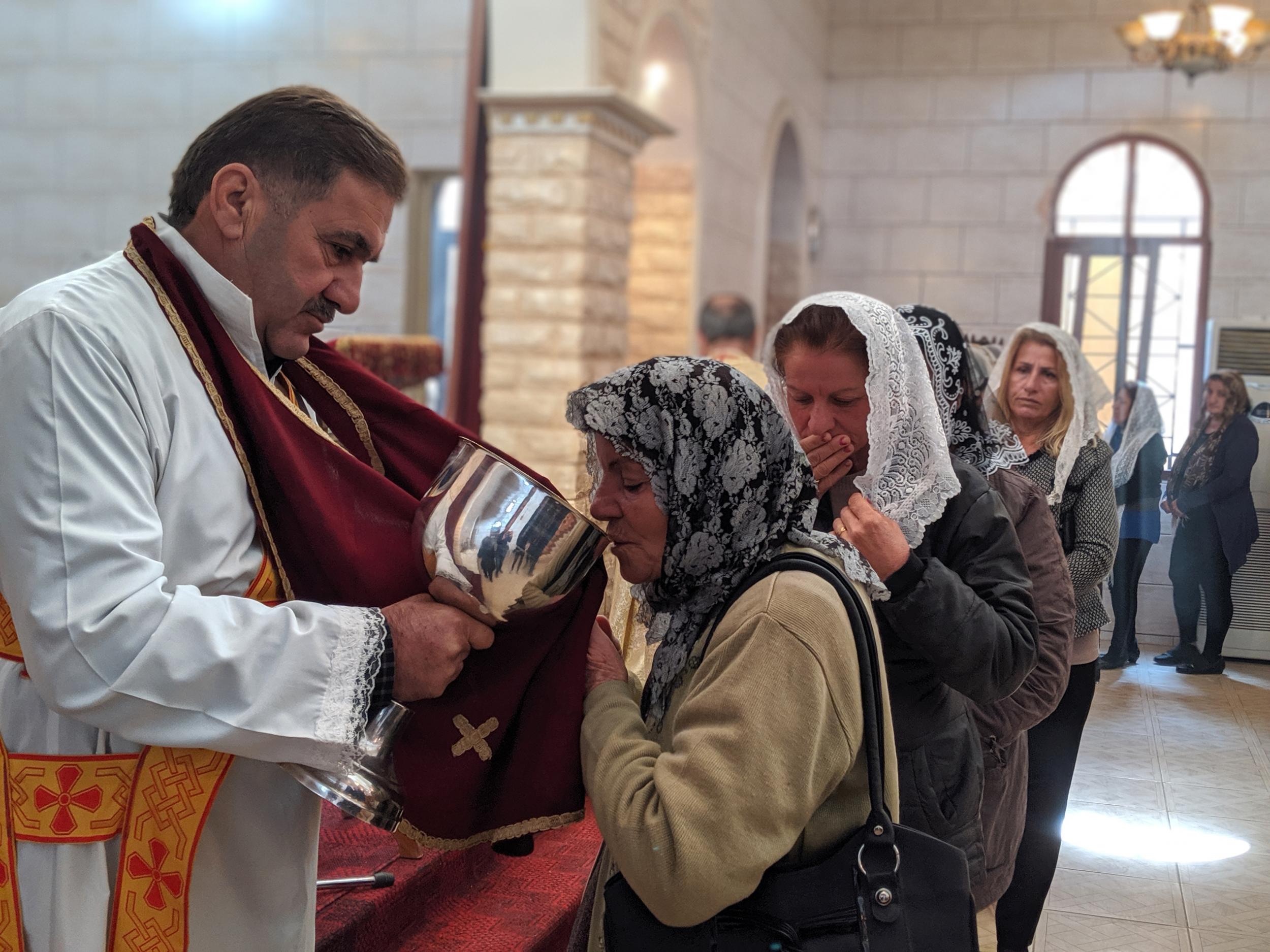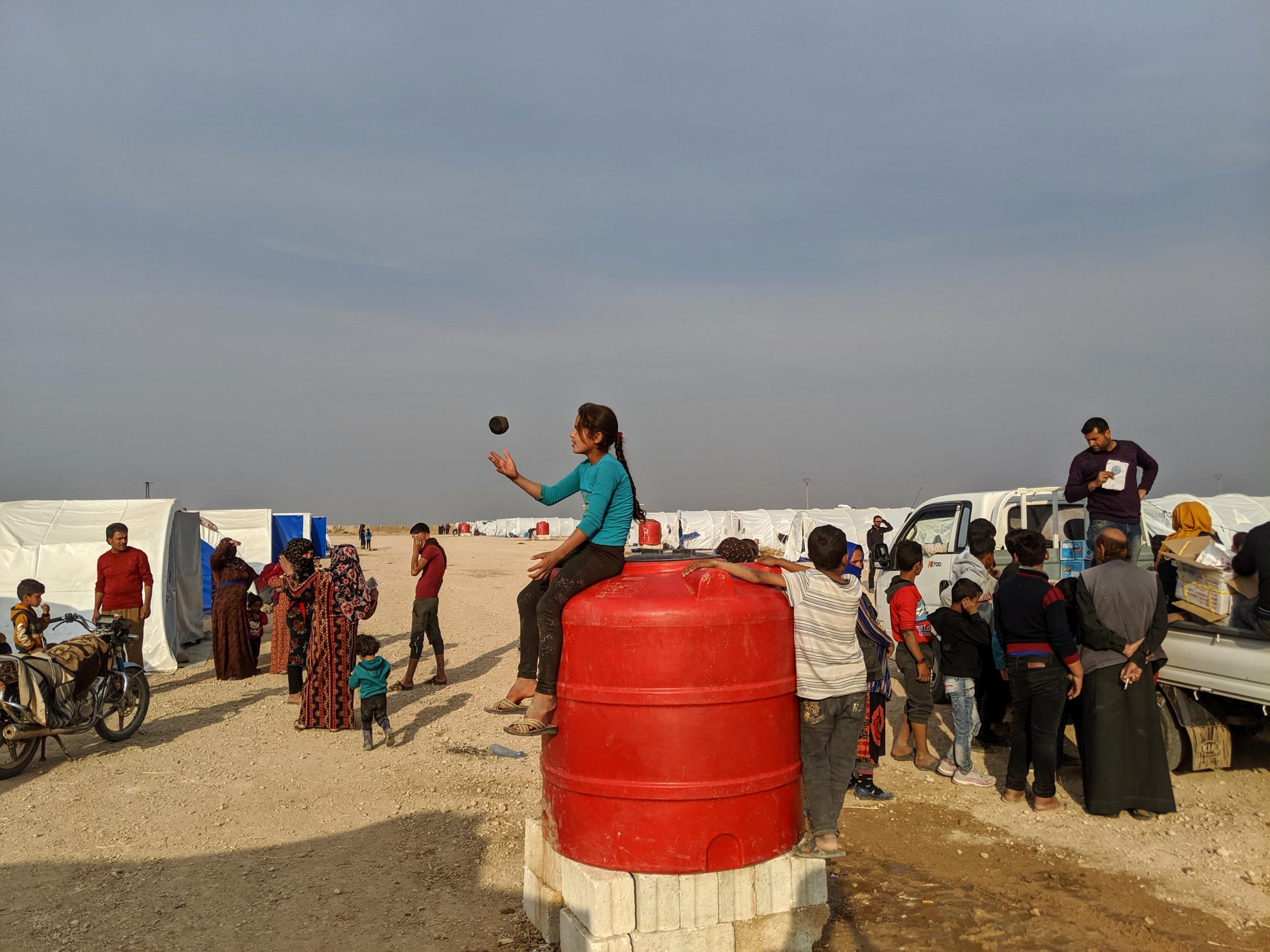‘You can hear the bombing right now’: Trump claims a ceasefire in Syria is working – but the casualties pile up
In the town of Tal Tamr, Richard Hall finds that a ceasefire announced with great fanfare by Donald Trump is non-existent

Your support helps us to tell the story
From reproductive rights to climate change to Big Tech, The Independent is on the ground when the story is developing. Whether it's investigating the financials of Elon Musk's pro-Trump PAC or producing our latest documentary, 'The A Word', which shines a light on the American women fighting for reproductive rights, we know how important it is to parse out the facts from the messaging.
At such a critical moment in US history, we need reporters on the ground. Your donation allows us to keep sending journalists to speak to both sides of the story.
The Independent is trusted by Americans across the entire political spectrum. And unlike many other quality news outlets, we choose not to lock Americans out of our reporting and analysis with paywalls. We believe quality journalism should be available to everyone, paid for by those who can afford it.
Your support makes all the difference.A black cloud looms over Tal Tamr. Great plumes of smoke rise from burning tyres lit by fighters defending this town, in northeast Syria, as they try in vain to block the view of the Turkish aircraft hunting them on the frontline a few miles away.
Residents of the surrounding villages are leaving in droves as the fighting draws closer. Wounded soldiers and civilians trickle in at the town’s only hospital. An American Apache helicopter circles above the fray, observing but not engaging – a metaphor not lost on the people below.
Hours earlier, Donald Trump declared from the White House that a ceasefire here was “holding very well”. For those living in the path of Turkey’s offensive, it was as if he was describing an alternate reality.
“What is he talking about? There is no ceasefire. You can hear the sound of helicopters and bombing right now,” says Dr Hassan Amin, the beleaguered director of Tal Tamr hospital.
No sooner has the doctor finished talking than a man is rushed into the emergency room with deep wounds on his leg and arm, his face covered in soot. He was hit by a mortar strike as he rode his motorcycle in a village to the north.
It has been like this for a month. This hospital alone has recorded more than 144 deaths and 600 wounded, most of them civilians. Just days ago, two civilians were killed by a Turkish drone strike as they travelled in their car near Tal Abyad.
“We haven’t seen casualties like this before,” says Dr Amin. “When we were fighting Isis, 99 per cent of casualties were bullets. Now all of them are wounded by airstrikes, shelling and rockets. People are coming without arms and legs, some with parts of their torsos missing.”
For the people of northeast Syria, the president’s words were yet another reminder of their abandonment by the US. They showed an administration completely detached from this conflict, apparently uninterested in its outcome.
For three years, the US provided support and arms to the Kurdish-led Syrian Democratic Forces (SDF) to fight and defeat the Isis caliphate. That support was abruptly withdrawn by Mr Trump last month, when the president gave Turkey the greenlight to attack their longtime foe.
Turkey launched its attack on 9 October, aiming to clear away the SDF from the border and implement a “safe zone” some 20 miles deep. Ankara views the Kurdish YPG militia, the largest component of the SDF, as a terror organisation for what it says are links to a group that has led a decades-long insurgency against the Turkish state. It says the safe zone is necessary for its own security.
More than 200,000 people have fled their homes and hundreds have been killed in the fighting since the offensive began. A ceasefire brokered by the Trump administration between the two sides last month was supposed to end the fighting in return for the lifting of US sanctions against Turkey.
But Syrian rebel forces, backed by Turkish airstrikes and artillery, have continued to push on against the SDF, capturing villages on the outskirts of Tal Tamr and threatening the town itself.
The ceasefire didn’t work for even one minute
Many in this diverse region of northeast Syria fear Turkey aims to dramatically alter its ethnic make-up. Turkey’s president, Recep Tayyip Erdogan, has promised to resettle 1 million Syrians displaced from other parts of the country in his proposed “safe zone”. To carry out the job, he has sent a patchwork fighting force of Syrian rebels, many of whom have a record of atrocities and have openly threatened to kill “infidels” – a reference to non-Muslims.
Gruesome videos have emerged of Turkish-backed fighters summarily executing Kurdish civilians as they captured a large area between the border cities of Ras al-Ayn and Tal Abyad. A Kurdish politician named Hevrin Khalaf, and her driver, were among the first killed.
Video recorded by one of the fighters at the scene showed the 35-year-old stopped in her car on a road in the path of the offensive. An autopsy report found that she was shot in the head at close range and her body mutilated.
Numerous reports of similar killings have emerged since, including the summary executions of captured fighters. It has sparked panic and fear among Kurdish, Assyrian Christians and Yazidi communities that live in the area.

At a church in the centre of the town, Priest Boghos Ichya has just finished a solemn service.
“The majority of Christians have left their villages and came to Tal Tamr in the last week,” he says.
The area’s Christian community has slowly been recovering from the damage done by Isis. In 2015, a similar wave of displacement befell them when the terror group besieged the town.
“This is nothing new. It has been happening since the time of Jesus,” the priest says. “We have suffered a lot in our land.”
Christian militias are now fighting on the frontlines to defend those villages. Some have changed hands and back again between the two sides in the last few days. Turkish jets and drones, a constant presence in the sky above Tal Tamr, are making the battle difficult.
“We didn't want to do the same thing we did with Isis when they came and took everything before,” says Jack Yuonadan, the church’s singer. “Besides, we don't have anywhere to go now, so we decided to stay and fight.”

The apparently ethnically motivated killings carried out by Turkey’s proxy army has caused widespread fear among all ethnic communities here. Many fear they will never be able to go back.
“They came for the Kurds. They came to kill us all,” says 18-year-old Hassan Omar Yunus, at a displacement camp a few miles down the road from Tal Tamr.
Nearly 200 families have arrived at this camp since it opened on 1 November. Yunus fled the city of Ras al-Ayn when fighting first began in early October. He went to Tal Tamr, where he stayed until a few days ago, when the battle came to the outskirts of the town. The supposed ceasefire touted by Trump never arrived.
“We hope to return home, but now we cannot. For sure they will kill us or kidnap us. Some people we know went back to get their stuff and they were kidnapped,” he says.
Basimad Daoud and her family, who are also stranded in the newly built camp, have more reason than most to fear the Islamist fighters who now occupy their village near Ras al-Ayn. They are both Kurdish and Yazidi. She sees little difference between the fighters who are on the march in northeast Syria and those of Isis.
“Our neighbours, who were Arab, told us to leave. They said 'When they come, they will kill you,'” says the 41-year-old.
“When we saw the murder of the politician, Havrin Khalaf, we saw they did the same thing that Isis did.”
“We were afraid they would kill us or take us as sex slaves,” she adds, referring to enslavement of thousands of Yazidi women by Isis in 2015.
Everyone in the camp has a similar story of fleeing in fear. Many have lost family in the fighting, or lost their homes. But the news of these casualties has not reached a distracted Trump.
As new arrivals to the camp stepped into the tents that would be their home for the foreseeable future, Mr Trump sat alongside Turkey’s president and said the Kurds were “very happy about the way things are going”.

There is now a sense of confusion in here about exactly what the US wants, especially from Washington’s one-time ally.
“The ceasefire didn’t work for even one minute,” Mustafa Bali, the SDF’s spokesperson, tells The Independent. “After it was announced they took six villages. Now, as we are talking, fighting is going on.”
“America has forces here on the ground. There are hundreds of journalists here, they can all see there is no ceasefire. If Trump cannot see what is going on, I don’t know what to say.”
The war here has become a surreal spectacle. Outside of Tal Tamr, people watch US military vehicles on patrol, passing trucks filled with people on their way to displacement camps. They can see US Apache helicopters flying above in the same airspace as the Turkish drones and jets bombing them. Hundreds of miles to the east, US troops that once protected them now stand guard over oil fields. In the middle of it all, Turkey and Russia carry out their own joint patrols.
Their fate, it seems, is being decided elsewhere. And they are unsure who is friend, and who is foe.
“They are throwing everything at us. Putin is clapping for them, Trump is clapping for them. If there is no one to stop them, of course they will come,” says Dr Amin.
Join our commenting forum
Join thought-provoking conversations, follow other Independent readers and see their replies
Comments